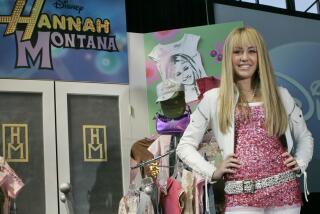Cartoon Network aims to turn prime-time tide with its Adult Swim
- Share via
When he takes command of CBS’ “Late Show” next year, Stephen Colbert will have to battle the two Jimmys, Fallon and Kimmel. But he’ll also square off against a robot chicken, a mad scientist and a talking hamburger.
From the humblest of beginnings 13 years ago — one early offering was made with microphones purchased at Radio Shack — Adult Swim, Cartoon Network’s nighttime block, has a powerful hold on one of the most highly sought-after populations around: young men.
Adult Swim’s mostly animated shows — among them hits such as “Robot Chicken,” “Aqua Teen Hunger Force” spinoffs and the new “Rick and Morty” — rely on absurdist, often surreal humor, and they’re making it harder than ever for the growing crowd of chat shows featuring celebrities hawking their latest movie.
The dorm-room-type nonsense fits the digital age.
PHOTOS: Creating Nickelodeon’s animated comedy ‘Breadwinners’
“I always fondly call them the Internet of television,” said Rob Corddry, a former star of Comedy Central’s “Daily Show” who co-created and stars in Adult Swim’s “Childrens Hospital,” a live-action comedy that parodies medical dramas. “They let the creators do their thing and they don’t stand in the way.”
“We’ve just kind of ridden that wave,” Mike Lazzo said in a recent phone interview. Lazzo, a 56-year-old high-school dropout with a thick Georgia drawl and a self-deprecating manner, has been the guiding light behind Adult Swim since its formal inception in 2001. Operations are tucked safely away from the Hollywood scrum in Atlanta, where parent company Turner Broadcasting, a Time Warner division, is based. “No one was really programming to a younger demo in that time period. And now it seems like everyone is.
“We didn’t have a lot of live action or talk shows,” Lazzo added. “We were something different, and I think a younger demo responds to that.”
They have responded so well, in fact, that as of March 31, Adult Swim — once confined strictly to late night — started airing as early as 8 p.m. Time Warner believes that the Adult Swim sensibility can capture the attention of young men in prime time just as well as it does after 11 p.m. But the move carries considerable risks as well, including bigger programming costs and a dilution of the brand’s off-the-wall reputation.
Asked to explain the move to earlier in the night, Lazzo deadpanned: “The company seems to really like money.” More seriously, he added: “The No. 1 goal is prime time. That’s where the largest audience is, and the largest financial opportunity.”
PHOTOS: Stories that leapt from big to small screen (and vice versa)
The push into prime time is already yielding big dividends. On Monday, “The Boondocks” Season 4 premiere logged the show’s highest ratings ever, with 3 million total viewers, according to Nielsen. This was despite the exit of creator Aaron McGruder, who’s developing another show for Adult Swim. It was the network’s best-rated prime-time telecast in five years among most of the demographic groups it targets.
A look at the late-night ratings shows why Adult Swim is putting pressure on its talk-show rivals — and how it could become a prime-time force. In the first quarter of 2014, “Family Guy” — Seth MacFarlane’s animated hit that Adult Swim acquired from Fox — averaged 2.8 million total viewers in its 11:30 p.m. airing, the same as CBS’ much more heavily promoted (and more expensive) “Late Show With David Letterman” averaged this season, according to Nielsen.
Even more attractive to advertisers is Adult Swim’s skew toward youth. The median viewer age is about 23 — an eye-popping figure, given that the median age of “Late Show” is 58.
“They built a brand where advertisers know they can reach young males,” said Chet Fenster, managing partner at ad firm MEC North America. Commercial buyers see the programming block as a clear alternative: “They’re all things that are a bit funny and a bit strange,” he added.
Lazzo has amped up the strangeness with some of the best-known comedy writers in the business — and then, as Corddry pointed out, letting them do pretty much whatever they want.
Dan Harmon rose to fame with NBC’s off-kilter sitcom “Community.” Now, working with writing partner Justin Roiland, he’s behind Adult Swim’s latest hit, “Rick and Morty” — a fast-paced quasi-parody of the “Back to the Future” series, this time about a mad scientist and his wide-eyed grandson. Since it premiered in December, the animated show has grown to beat everything on the broadcast networks among men under 35. Harmon says the creative freedom is key.
CRITICS’ PICKS: What to watch, where to go, what to eat
“When we get notes, we’re talking to one guy in Atlanta, who’s in charge of everything,” said Harmon, whose battles with NBC executives over the creative direction of “Community” led to his temporary departure from the series. “We take those notes because that’s one person being sincere in his reaction to the material and not trying to politick within a hierarchy, and also not trying to guess what an audience wants.”
Dave Willis, who helped craft “Aqua Teen Hunger Force” — about a group of fast-food items that sit around a house and insult each other — into Adult Swim’s longest-running show, agrees that Lazzo’s role as impresario is crucial.
“His taste is for more absurdist comedy,” said Willis, who’s also behind the animated spoof “Squidbillies” and the live-action “Your Pretty Face Is Going to Hell.”
“Frankly, that type of comedy — which is really popular on the Internet — is not that prominent on broadcast or even on cable,” Willis said.
Lazzo realizes the challenges ahead. Moving into prime time has forced Adult Swim to take a broader, more relatable approach to comedy — as in “Rick and Morty,” which, while still off-the-wall, hews much more closely to traditional narrative and characterizations a la “The Simpsons.” And while buying existing shows like “Family Guy” is fine, the real money is in original shows. That is expensive — in some cases, producing original episodes can cost upward of $1 million each.
So far, the expansion has worked, with “Rick and Morty” finding a large audience at 10:30 p.m.
But “we can’t lose our late-night sensibility, which is what started the whole thing,” Lazzo said. “It’s a really fascinating time to be in this business. We have our work cut out for us.”
Corrected: An earlier version of this post included a headline that said Cartoon Central instead of Cartoon Network.
More to Read
The complete guide to home viewing
Get Screen Gab for everything about the TV shows and streaming movies everyone’s talking about.
You may occasionally receive promotional content from the Los Angeles Times.







